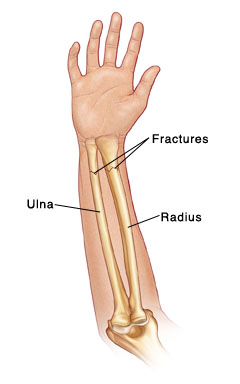Your forearm is made up of two bones: the radius (on your thumb side) and the ulna (on your pinkie side). The main motion of the forearm is rotation, which is the ability to turn your palms up or down. In most cases of forearm fracture, both bones are broken. The bones are not out of place and won't need to be set. Depending on your age and general health, this fracture often takes 6 to 12 weeks to heal completely.
Treatment usually starts with a splint or cast to keep your arm in position. Unlike a full cast, a splint can be tightened or loosened and allows swelling to occur safely.
Home care
-
Keep your arm raised to reduce pain and swelling. When sitting or lying down, raise your arm above heart level. You can do this by placing your arm on a pillow that rests on your chest or on a pillow at your side. This is most important during the first 48 hours after injury.
-
Apply an ice pack over the injured area for 15 to 20 minutes every 3 to 6 hours. You should do this for the first 24 to 48 hours. To make a cold pack, put ice cubes in a plastic bag that seals at the top. Wrap the bag in a clean, thin towel or cloth. Never put ice or an ice pack directly on your skin. As the ice melts, be careful that the cast or splint doesn’t get wet. You can place the ice pack inside the sling and directly over the splint or cast. Keep using ice packs as needed to ease pain and swelling.
-
Keep the cast or splint completely dry at all times. Bathe with your cast or splint out of the water. Protect it with 2 large plastic bags, one outside of the other, each taped with duct tape at the top end or secured with rubber bands. If a fiberglass splint or cast gets wet, you can dry it with a hair dryer on a cool setting. Do not set the dryer on a warm or hot setting, as it may burn your skin.
-
Do not apply powder or lotion on, near, or inside the cast. Do not try to insert anything in your cast. This can injure your skin, which may lead to infections.
-
You may use over-the-counter pain medicine to control pain unless another pain medicine was prescribed. If you take a blood thinner, have chronic liver or kidney disease, or ever had a stomach ulcer or digestive system bleeding, talk with your health care provider before using these medicines.
Follow-up care
Follow up with your health care provider as advised. Your provider will follow your progress with repeated X-rays to monitor the healing and any shifts or changes in the position of the fractured bones. If a splint was applied, it may be changed to a cast during your follow-up visit.
If X-rays were taken, you'll be told of any new findings that may affect your care. If the position of your fractured bones shifts or changes, you may need surgery to put the bones back together. You may be referred to an orthopedist for more care.
As forearm fractures can affect your ability to rotate your arm, as well as bend and straighten the wrist and elbow, it is important to do physical therapy. This is usually started after a few weeks of keeping the arm still by using a cast or brace. Your physical therapist will recommend appropriate exercises at every stage of your recovery to:
-
Restore your range of motion.
-
Strengthen your muscles and restore your grip strength.
-
Reduce stiffening of the elbow and wrist joints due to lack of movement in the cast or brace.
-
Restore the function of your forearm and help you return to your activities.
Your provider will advise you on when you may return to work and sports activities.
When to get medical advice
Call your health care provider right away if any of the following occur:
-
The plaster cast or splint becomes wet or soft.
-
The fiberglass cast or splint remains wet for more than 24 hours.
-
Increased tightness, looseness, or pain occurs under the cast or splint.
-
Your fingers become swollen, cold, blue, numb, or tingly.
-
The cast or splint has a bad odor.
-
Your forearm becomes swollen, feels tight or tender, or the skin is pink.
-
Your forearm doesn't get better with rest or by doing things to relieve pain, such as using ice or taking medicines for pain.


